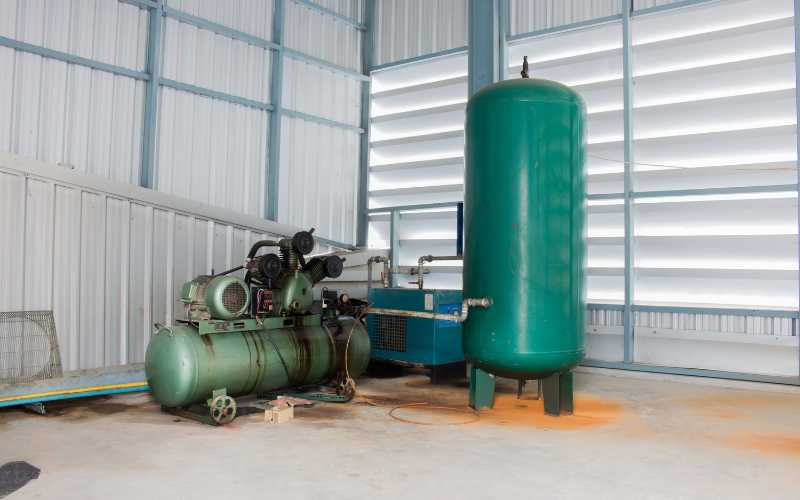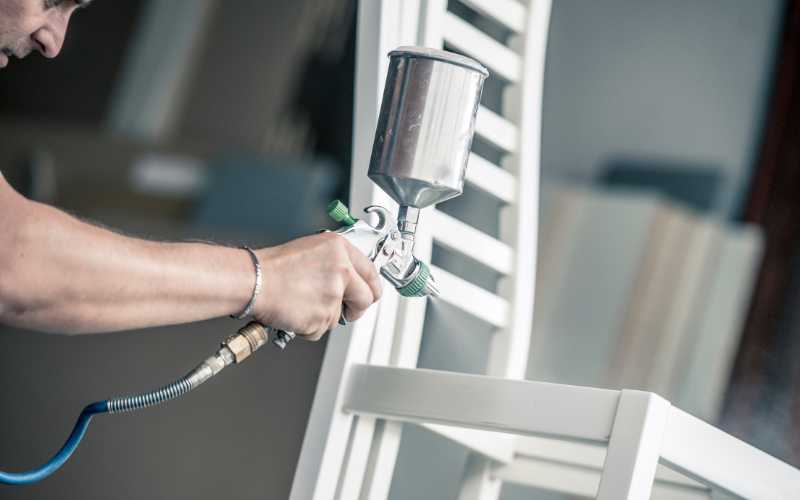Choosing an air compressor for spray painting can be quite challenging especially if you’re are a beginner.
The truth however is, any size of air compressor will run your spray gun, but it all depends on how long that spray gun will run before the air in the tank runs out. That’s why it’s important that you make your choice wisely.
If you’re still using a brush and roller for your painting projects, then you’re obviously missing out on the thrill and efficiency of using a paint sprayer powered by an air compressor.
There are many disadvantages of using a brush and roller as opposed to using a paint sprayer. One of the more obvious ones is the marks left by rollers on the painted surface.
Since a roller will always leave it’s marks on the painted surface, it is not always the ideal tool for a professional painting job, especially when you’re painting surfaces like car panels. With a sprayer, you can achieve a high degree of smoothness on the surfaces.
One more reason why using a paint sprayer is better is that it saves a lot of time. With a spray gun, you get to paint whatever surface you’re working on in a fraction of the time it will take when you use a brush and roller.
There are different types of paint sprayers. Some are powered by air compressors, while others don’t make use of compressed air to function.
In this article, we’ll talk about how you can choose the right air compressor to power your paint spray gun.
When choosing an air compressor, you have 2 major factors to consider.
Factors To Consider When Choosing An Air Compressor For Spray Painting
- Tanks Size
- Type of Spray Gun
Tanks Size

The most crucial factor to consider when choosing an air compressor for spray painting is the size of the air compressor unit itself.
Any unit between 4 to 80 gallons will run your paint gun. The issue however, is how long will they run the paint gun.
Unlike other pneumatic tools like nailers, which use air intermittently to fire nails, paint sprayers require a continuous flow of compressed air to work properly.
A small tank unit like 4 to 10 gallons, will run the paint gun, but not for long. It’s going to stop abruptly when you’ve not even covered enough area.
However, if the area you want to paint is very small, then a small air compressor unit can be enough. For example, if you want to paint just the corner of a car bumper or a small part of your car fender, a 6 or 10 gallon unit can get the job done.
On the other hand, if you want to spray paint the whole bumper or the whole fender, then a 6 or 10 gallon unit will not be enough for that. It will fall short. The tank will empty before you’ve covered the whole fender.
What you need in this instance, is a 20 to 30 gallon air compressor unit. This will be enough to spray paint a whole bumper or fender without the tank running empty.
If you want to spray paint the whole car, a 20 to 30 gallon unit, will not be enough. What you need is from 60 to 80 gallons.
That will run your spray gun continuously until the whole car is complete. So, most of the time, it’s all about the amount of air you have stored in a tank and the pressure. The size of the tank, determines how long you can spray the paint without losing pressure.
As for the tank, it will fill up quickly, only if you have a very powerful motor and a pump to suck air into it.
Type of Paint Gun

The type of paint gun you use, and its CFM or air volume requirement is also vital. There are different types of spray painting guns available today.
There are HVLP (high volume low pressure), LVLP (low volume low pressure), and airless paint sprayers available for you to choose from.
The type you choose should also determine the type and size of air compressor you go for.
If you’re using an HVLP spray gun, you need a sizeable air compressor unit with a big tank. Most of the sprayers available today are HVLP and they rely on a high volume of air to deliver fine atomized paint on the surface they’re being used on.
LVLP sprayers uses a low volume of air, and airless sprayers don’t use air compressors at all. They make use of a high pressure pump to atomize the paint.
If you’re using an HVLP or LVLP spray gun, then you’re going to need an air compressor machine. What you need to consider here, is the CFM requirement of the spray gun.
CFM stands for cubic feet per minute. In other words, it is the volume of air produced by the air compressor per minute. It’s not the force of the air, it’s quantity of air produced at a certain pressure, say 90 PSI.
The CFM is a very important parameter you need to check for if you’re shopping for an air compressor for your spray painting project or business.
To be on the safe side, first of all, you need to check the CFM requirement of the spray gun you intend to use.
After you determine the CFM of the spray gun, you need to make sure that the air compressor you choose produces more than the CFM of the spray gun.
Both of their CFM should not be the same. You need to get one that produces more than the CFM of the spray gun.
Any mistake here can cause your spray gun not to work efficiently. So, make sure you give this serious consideration.
You must consider these factors if you need an air compressor for some serious spray painting projects.

